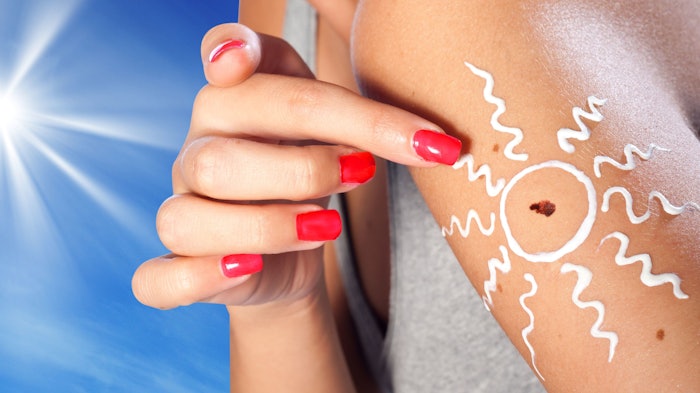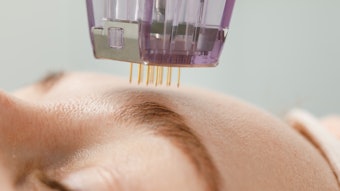
Consumers seem to be finally taking the serious issue of skin cancer and the need to wear adequate sun protection seriously after years of the medical community as a whole diligently spreading awareness and urging the population to take this issue to heart. While the increase in consumer's "sunxiety" and willingness to wear sun protection is an encouraging change, there is still much farther to go before the skin cancer epidemic in this country is truly dealt with.
In an effort to further spread awareness of the magnitude of this situation, over 20 organizations are urging the US surgeon general to renew the previous skin cancer call to action. Thankfully, in addition to this, a recent survey by Veylinx identified what sun protection skin care brands and practitioners can do to encourage patients and consumers to wear sun protection. Advanced formulations that address consumers other skin care needs in addition to sun protection, as well as educating patients about the damaging effects of UV exposure as well as the benefits of consistent photoprotection are complementary two avenues we can take to address this problem.
Push for U.S. Surgeon General to Renew Skin Cancer Call to Action
The American Society for Dermatologic Surgery Association (ASDSA), along with the American Academy of Dermatology Association (AAD), the National Council on Skin Cancer Prevention (NCSCP), and 21 other prominent dermatologic associations and skin cancer prevention organizations, are urging the U.S. Surgeon General to revive the Call to Action to Prevent Skin Cancer. With the alarming statistic that one in five Americans is expected to develop skin cancer before reaching 70 years of age, this malignancy represents an urgent public health concern affecting millions nationwide.
In 2014, U.S. Surgeon General Dr. Boris Lushniak issued a crucial Call to Action, mobilizing all Americans to combat skin cancer and declaring it a public health crisis. While the 2014 initiative yielded positive outcomes, skin cancer remains the most prevalent cancer in the United States, with nearly 5.5 million cases diagnosed annually – surpassing the combined incidence of breast, colon, lung, and prostate cancers. Recognizing the ongoing threat to Americans' health, organizations dedicated to skin cancer education, prevention, and research are imploring the Surgeon General to reinstate the Call to Action and implement comprehensive skin cancer prevention strategies. These include investing in measures to limit public ultraviolet (UV) exposure, promoting sunscreen use, and engaging in evidence-based sun safety education to counter misinformation proliferating on various media platforms.
"Skin cancer affects individuals across all age groups, including children. Research indicates that over 40% of a person's lifetime UV exposure occurs before the age of 20, and multiple childhood sunburns double the risk of developing skin cancer later in life," stated ASDSA President Seth Matarasso, MD. In response to these concerning statistics, the Centers for Disease Control and Prevention (CDC) has advocated for enhanced sun protection measures for both children and adults, including the promotion of sunscreen use and protective clothing.
"The American Academy of Dermatology Association (AADA) stands in solidarity with ASDSA and other partners in urging the Surgeon General to prioritize skin cancer prevention measures. Skin cancer remains the most prevalent cancer in the United States, with nearly 5.5 million cases diagnosed annually. It is imperative that we raise awareness about the risks associated with sun exposure and the high incidence of skin cancer," emphasized AADA President Seemal R. Desai, MD.
A unified call to action would facilitate collaboration among leading health associations, governmental and non-governmental agencies, businesses, and healthcare providers, positioning us to make significant strides towards our shared goal of reducing skin cancer rates. The expert signatories eagerly anticipate the opportunity to engage with the Surgeon General and policymakers, including continued partnership with the Congressional Skin Cancer Caucus, to spearhead this initiative aimed at raising awareness and implementing more robust measures to protect Americans from skin cancer.
"Sunxiety" Among Consumers
Veylinx conducted a comprehensive analysis of consumer preferences and price sensitivity regarding standard sunscreen formulations versus innovative variants with enhanced properties. The results illuminate an increasing public cognizance of photoprotection benefits and a demand for multifunctional solar defense products. Formulations incorporating anti-aging components elicit a 49% surge in consumer interest, followed by hydrating variants (33% increase) and those enriched with ascorbic acid (23% rise). These augmented benefits not only amplify demand but also elevate consumers' willingness to invest in superior photoprotection solutions.
Sun Safety Attitudes & “Sunxiety”
The research elucidates a paradoxical relationship between heliophilia and heliophobia among the populace. While 71% relish solar exposure, 38% experience persistent unease during sun-soaking activities. A significant 60% report heightened photosensitivity, with 41% expressing dermatological apprehension. Recent Google Trends data indicates unprecedented search volumes for "what does skin cancer look like" and "sunscreen" in the United States. These metrics underscore an escalating trepidation surrounding UV exposure and underscore the imperative for sustained public education initiatives. The data emphasizes the criticality of elucidating both the potential dermatological hazards associated with unprotected solar exposure and the prophylactic benefits of consistent, appropriate sunscreen application in mitigating these risks.
Sunscreen Efficacy and Consumer Preferences
Dermatological research reveals that hydrating formulations command premium pricing, while anti-aging variants from Supergoop, Cerave and Olay demonstrate heightened consumer demand. Notably, 27% of individuals opt for reef-safe formulations, exhibiting a willingness to pay a 14% premium—potentially serving as a significant revenue catalyst for manufacturers. This trend suggests an increasing marine-conscious demographic; however, only 16% prioritize sustainable packaging, with minimal price elasticity observed.
Patterns in Photoprotection Utilization
The study's findings elucidate encouraging usage trends: 30% of respondents apply sunscreen daily during estival months, with an additional 21% utilizing it 5-6 times weekly. Moreover, 65% of consumers prefer formulations with SPF exceeding 40, indicating a robust demand for enhanced photoprotection. However, only 27% maintain year-round application, while 32% limit usage to sunny summer days, underscoring the necessity for continued education on perennial sun safety. Interpersonal recommendations (42%) exert the greatest influence on product discovery, followed by social media platforms (35%). Notably, 29% of parents employ distinct formulations for their progeny.
Market Opportunities for Dermocosmetic Brands
The research identifies significant market potential for multifunctional photoprotective products. Fifty-seven percent of respondents opt for SPF-integrated moisturizers, while nearly three-quarters prefer tinted foundations with inherent sun protection. Furthermore, transparent formulations designed to minimize residual white cast were found to augment demand by 16% compared to conventional lotions and creams, highlighting a clear preference for aesthetically pleasing, multifunctional photoprotective solutions.











